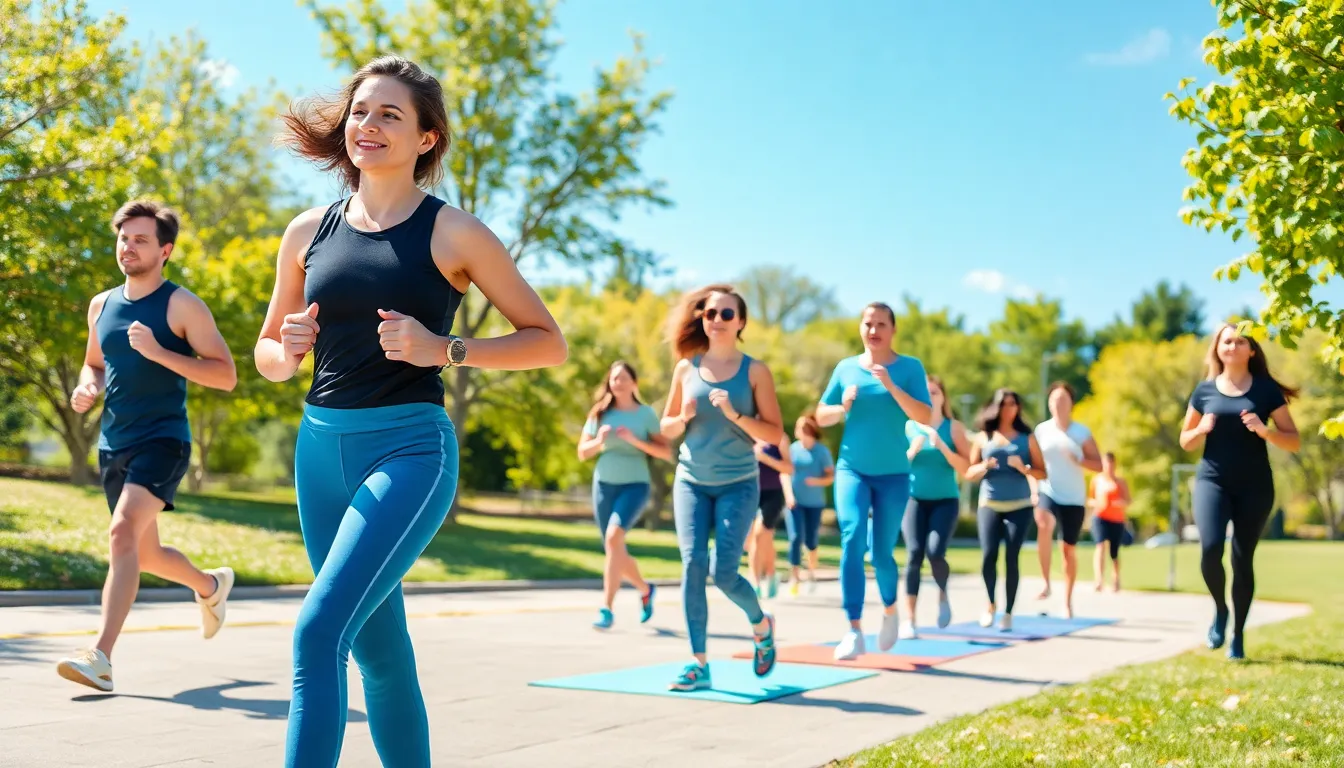Physical wellness isn’t just about fitting into those jeans from high school; it’s the secret sauce to living life to the fullest. Think of it as your body’s way of saying, “Hey, I’m ready for that hike, dance-off, or spontaneous beach trip!” When someone embraces physical wellness, they’re not just chasing abs or a perfect physique. They’re investing in energy, strength, and a zest for life that makes every day feel like an adventure.
What is Physical Wellness
Physical wellness encompasses a holistic approach to health, focusing on the body’s overall function and vitality. It includes maintaining a balanced diet, engaging in regular exercise, and prioritizing sleep. A commitment to physical wellness contributes significantly to mental health and emotional stability.
Engaging in physical activity strengthens muscles and improves cardiovascular health. It can involve various activities such as walking, swimming, or practicing yoga. Regular movement not only boosts physical stamina but also enhances mood and reduces stress.
Nutrition plays a critical role in physical wellness. Consuming whole foods, including fruits, vegetables, and lean proteins, fuels the body and supports immune function. Individuals who prioritize balanced nutrition often experience increased energy levels and improved mental clarity.
Adequate hydration also supports physical wellness. Drinking sufficient water aids digestion, regulates body temperature, and maintains joint lubrication. Making hydration a priority can lead to enhanced overall health.
Preventive healthcare measures contribute to physical wellness. Regular checkups, screenings, and vaccinations can identify potential health issues early. Individuals who stay proactive about their health often enjoy a higher quality of life.
Physical wellness involves cultivating healthy habits. Reducing unhealthy behaviors like smoking or excessive alcohol consumption can lead to significant health improvements. Creating a supportive environment encourages sustained physical wellness.
This comprehensive view of physical wellness emphasizes its importance not just for appearance, but for enriching life experiences and enhancing vitality.
The Components of Physical Wellness

Physical wellness encompasses several key components that contribute to overall health and vitality. Nutrition, exercise, and sleep play significant roles in enhancing well-being.
Nutrition
Nutrition serves as the foundation for physical wellness. Consuming a variety of whole foods like fruits, vegetables, and lean proteins provides essential nutrients that fuel the body. For those looking to further support cognitive function, supplements such as nootropics can help—here’s a guide on where to buy nootropic supplements online. Whole foods support immune function and maintain energy levels. In addition, adequate hydration ensures proper digestion, temperature regulation, and joint lubrication. Prioritizing balanced meals maintains stable blood sugar levels and reduces the risk of chronic conditions. Choosing nutrient-dense options supports mental clarity and emotional stability.
Exercise
Exercise significantly impacts physical wellness by improving cardiovascular health and increasing strength. Engaging in activities like walking, swimming, or yoga enhances stamina and boosts mood. Regular physical activity strengthens muscles and bones, promotes better posture, and helps maintain a healthy weight. An effective routine includes both aerobic and strength training activities, aiming for at least 150 minutes of moderate-intensity exercise weekly. Making exercise a priority not only promotes physical endurance but also reduces stress and anxiety.
Sleep
Sleep is a critical component of physical wellness that affects overall functioning. Adequate rest improves mood, cognitive performance, and immune function. Adults typically need between 7 and 9 hours of quality sleep each night. Establishing a consistent sleep schedule supports restorative processes that rejuvenate both body and mind. Creating a comfortable sleep environment, minimizing screen time before bed, and practicing relaxation techniques can enhance sleep quality. Prioritizing sleep leads to better energy levels and helps sustain vitality during daily activities.
Benefits of Physical Wellness
Physical wellness offers numerous benefits that positively impact overall health. Enhanced mental well-being often emerges as a key advantage. Regular physical activity, like brisk walking or yoga, contributes to improved mood and emotional stability, alleviating symptoms of anxiety and depression. Engaging in these activities stimulates the production of endorphins, promoting a sense of happiness and reducing stress levels. Increased energy leads to a more productive daily life, enabling individuals to tackle tasks with enthusiasm.
Enhanced physical performance stands out as another critical benefit. Participating in regular exercise strengthens muscles, increases stamina, and boosts cardiovascular health. Individuals benefit from improved coordination, agility, and flexibility. Research shows that engaging in at least 150 minutes of moderate-intensity activity weekly significantly contributes to overall fitness levels. Building strength and endurance allows individuals to perform daily activities with greater ease, while also enabling participation in recreational sports or hobbies. Ultimately, physical wellness fosters vitality and resilience, enhancing life experiences and supporting core wellness.
Common Barriers to Achieving Physical Wellness
Several factors hinder individuals from achieving physical wellness. Understanding these barriers can lead to effective solutions.
Sedentary Lifestyle
A sedentary lifestyle significantly impacts physical wellness. Many spend extended hours sitting at desks or lounging on couches. Poor habits in this area can reduce muscle strength and cardiovascular fitness. Engaging in regular movement, such as walking or stretching, serves as an antidote. The American Heart Association recommends at least 150 minutes of moderate-intensity exercise weekly. Prioritizing small changes within daily routines enhances activity levels. Standing while working, taking short breaks for movement, and incorporating physical hobbies contribute to overall wellness.
Poor Dietary Choices
Poor dietary choices form another major barrier. Many opt for processed foods high in sugar, fat, and sodium, which detract from nutritional health. Whole foods like fruits, vegetables, and lean proteins provide essential nutrients necessary for energy and immune function. Individuals often overlook the connection between diet and mental well-being. Consuming a balanced diet helps maintain stable blood sugar levels and improves mood. Planning meals ahead promotes healthier eating habits. Incorporating variety in food choices fosters better nutritional intake and supports long-term health.
Strategies for Promoting Physical Wellness
Promoting physical wellness involves practical approaches that foster a healthier lifestyle. Individuals can achieve greater physical wellness through strategies that encourage consistent practices.
Setting Realistic Goals
Setting realistic goals creates a clear path toward better wellness. Individuals benefit from establishing specific, measurable, achievable, relevant, and time-bound objectives. For example, aiming for 30 minutes of moderate exercise five times a week helps create consistency. Planning short-term milestones encourages motivation and accountability. People who track their progress gain insight into their achievements, reinforcing positive changes over time. Achieving small goals leads to a sense of accomplishment, ultimately paving the way for larger aspirations.
Incorporating Activity into Daily Life
Incorporating activity into daily life makes fitness more accessible. Simple changes can yield significant benefits. For instance, opting for stairs instead of elevators boosts cardiovascular health. Individuals can take short walks during breaks or engage in active hobbies like gardening or dancing. Biking or walking to work adds exercise without requiring extra time. Scheduling physical activity into routines makes it feel like a natural part of life. Engaging the family in physical activities fosters fun and togetherness while promoting wellness.
Conclusion
Physical wellness is a vital aspect of a fulfilling life. It’s not just about looking good but about feeling good and living actively. By embracing a holistic approach that includes proper nutrition regular exercise and sufficient sleep individuals can significantly enhance their quality of life.
Overcoming barriers like a sedentary lifestyle and poor dietary choices is essential for achieving physical wellness. Small changes in daily routines can lead to significant improvements. Prioritizing health through consistent habits fosters not only physical strength but also emotional resilience and mental clarity.
Ultimately investing in physical wellness enriches life experiences and promotes a vibrant and energetic lifestyle. It’s about creating a balanced life where health and happiness go hand in hand.














Discussion about this post